#border outpost china borders
Explore tagged Tumblr posts
Text
There has been major developments in the region in the past few days that indicates regional war is imminent. Again the tweets and articles will be in chronological order.
American war ships are in the Mediterranean and Red Seas. Russia responded to that by sending planes to the Black Sea and China by sending warships to Kuwait.

We got our usual back and forth on the ground operation in Gaza



The American media is not really reporting these recent attacks on their military bases. In fact, the military is downplaying the strength of the responses by Yemeni and Syrian groups to the Gaza genocide. This is either because they want to avoid regional war or because they want to be better prepared for regional war.
This statement below seems to indicate that Iran is coming to the conclusion that open warfare is the only thing that will deter America and Israel

As for Yemen, they've declared Israeli ships will be targeted if the attack on Gaza continues (you'll see later that this is no empty threat)
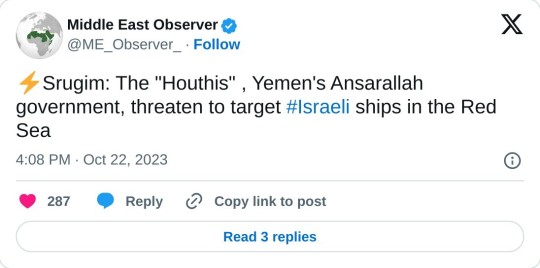
By the way, Israel bombed an Egyptian military site along the border and claimed it was an accident. The Egyptian people have been calling for their government to intervene militarily and I don't think this will ease the pressure.
On the 22nd, Israel sent a small team to infiltrate Gaza. They didn't get very far

They're also struggling against Hezbollah


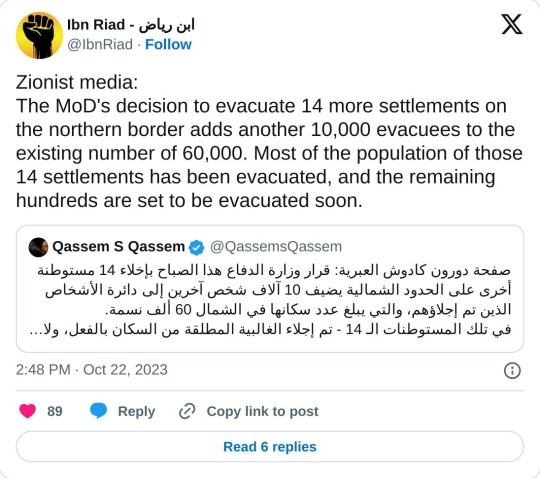
This meeting by the Russian foreign minister is a big deal as you'll see later
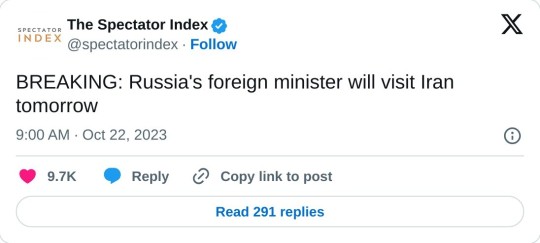
America responds to the escalating tension by deploying 'defensive systems' all over West Asia. It risks stretching itself too thin as multiple countries are already involved in the Palestian resistance with countries like Egypt and Jordan facing internal pressure to do something about the Gazan genocide
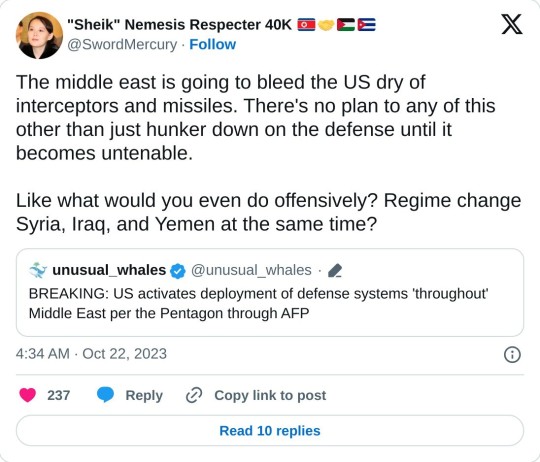
Republican Mitch McConnell has recently called Iran, Russia and China 'the new axis of evil'. It seems this is the new angle that the West has chosen because Rishi Sunak has also been comparing Hamas to Russia. This can only lead to Russia getting close to Iran which would ultimately help Hamas.
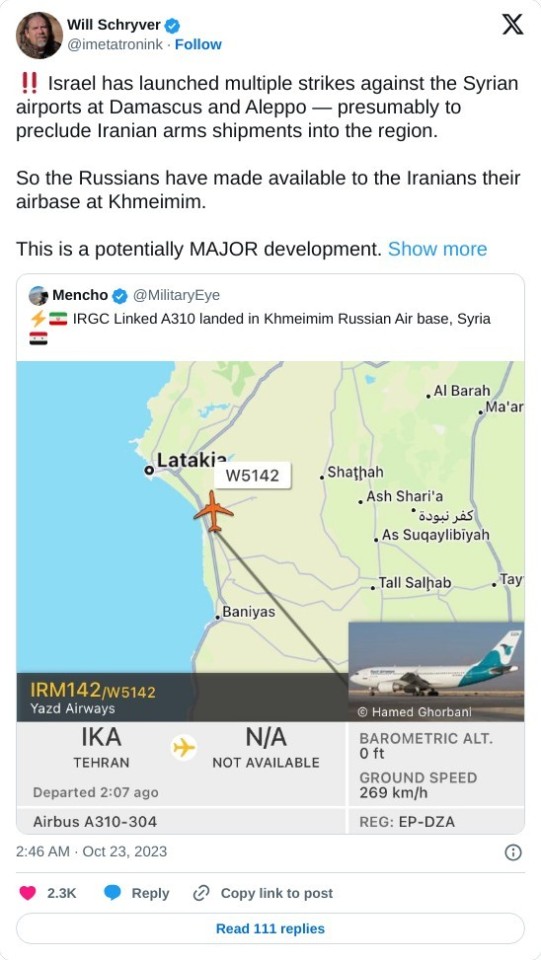
The situation in Iraq continues to deteriorate as America evacuates its embassy and warns its citizens not to use the Baghdad International Airport due to attacks by Iraqi military groups.
Here we have an Israeli commander admitting that Israel is largely on the defensive against Hezbollah and their soldiers are both traumatised and disheartened. Remember, Hezbollah has yet to officially enter the war

Blinken said that the US 'will be prepared' if Iran escalates its attacks which gives weight to that idea that the US is only trying to deescalate because its not ready yet.
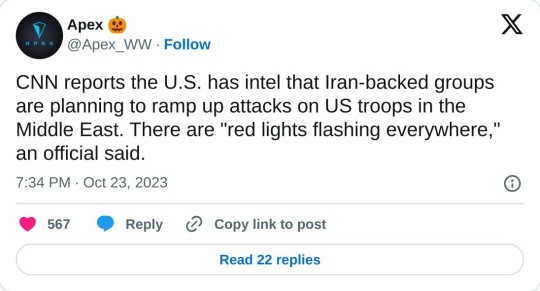
A few hours ago, American bases in Syria were targeted. It's becoming clear that a major goal in the plan to defeat Israel is removing America from the picture in the region
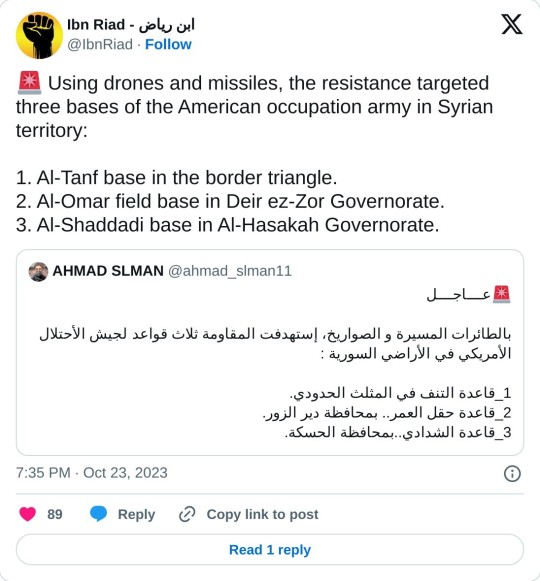

The White House then blames Iran for the attack
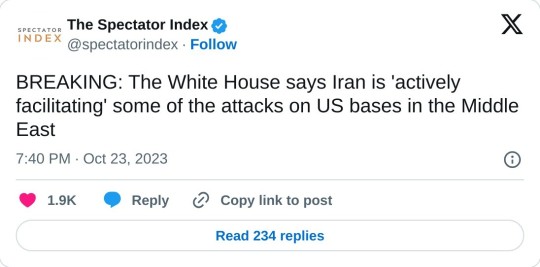
More military bases targeted in Iraq
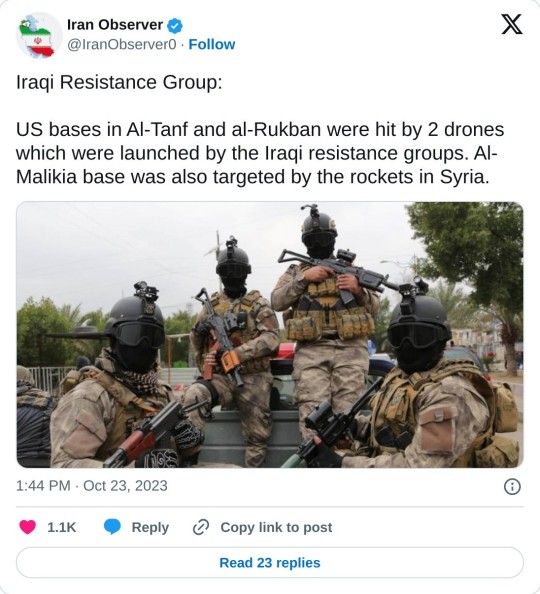
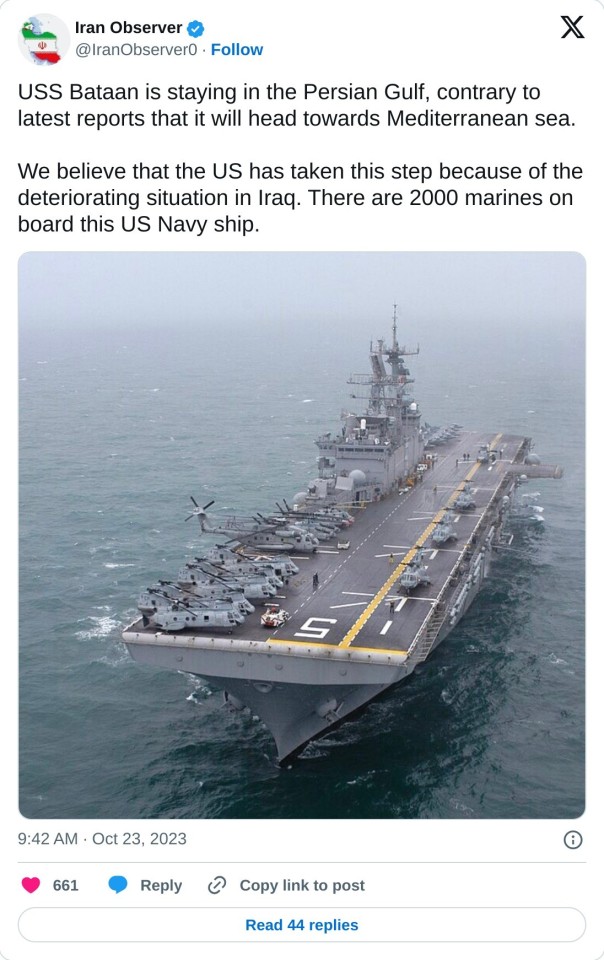

Meanwhile IDF is trying to infiltrate Gaza again. Reminder that a ground operation means that Hezbollah will officially enter the war and begun using its vast numbers of missiles and rockets. They're also attacking the West Bank, the resistance fighters have ambushed them
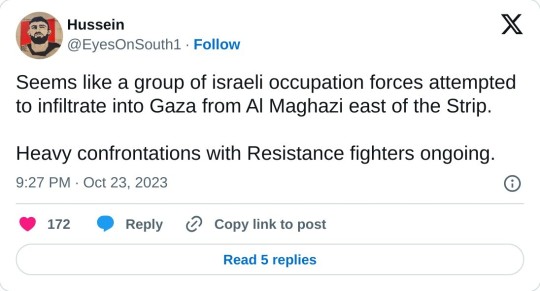
Yemen follows through on the threats it made by attacking a US warship with drones
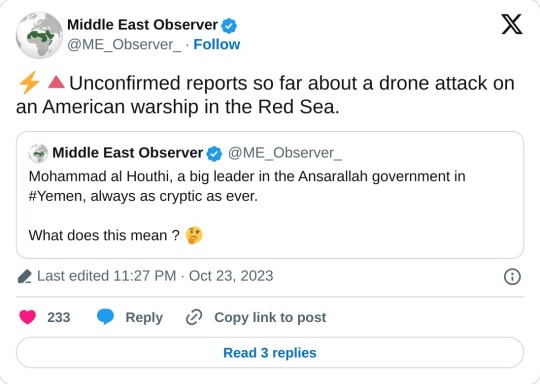

Ansarullah claims there was a direct hit but the US Navy says that all drones were intercepted (using days old pictures).
So what now? First, do not expect a ceasefire. Tbh the Palestinian resistance hasn't even called for ceasefire, just an exchange of hostages.

Second of all, America itself does not believe that Israel can win this war so let's all stop acting like Palestine has already lost
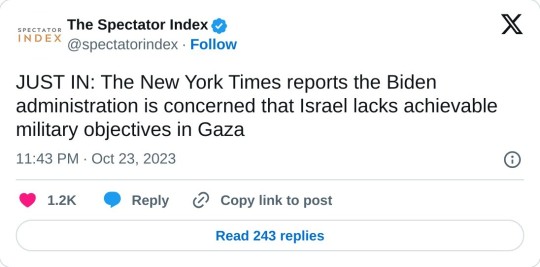
Thirdly, regional war is looking more and more like reality
1K notes
·
View notes
Text
The Hearts of Darkness: Apocalypse Now Short Essay
By: Jillian Arnold
"The horror... the horror..."
The movie Apocalypse Now is a war-horror film that came out in 1979 that has been named one of the best war films ever made. Its troubles in the film and outside with filming makes it memorable to film makers and audiences alike.
The movie is set at the height of the Vietnam War in 1969 and follows the mission of U.S. Army Captain Willard. He is sent on a mission by Lieutenant Lucas and a General that “does not exist nor will it ever exist” to travel up the Nung River in the U.S. Navy patrol boat to assassinate a Colonel Kurtz, who's gone AWOL and acts like a demi-god to a group of tribal natives in the jungle. After some hair-raising encounters, in which some of his crew are killed, Willard, Lance and Chef reach Colonel Kurtz's outpost, beyond the Do Lung Bridge. As Willard nears the end of his mission, he soon finds himself reeling in the horrors and sanity of war itself as he confronts the colonel face to face in which Willard's true nature begins to emerge slowly. Willard confronts not only the same horrors and hypocrisy that pushed the level headed Colonel Kurtz over the edge into an abyss of insanity, but the primal violence of human nature and the darkness of his own heart.
youtube
Here is a newer trailer to the movie, Apocalypse Now. I used this trailer because I felt as though it gave more insight to the plot of the movie and allowed audiences to gauge how much violence is in the movie. It is also a somewhat chaotic trailer that reflects the chaos of the movie with the war and the turbulence in the main character, Captain Willard’s, mind.
The movie was released into theatre on August 15th, 1979 and was directed by Francis Ford Coppala. With the movie’s budget of $31,500,000, it earned $104,920,499 worldwide. The film starred Martin Sheen as Capt. Benjamin L. Willard, Marlon Brando as Col. Walter E. Kurtz, and Robert Duvall and Lt. Col. Bill Kilgore. The film had twenty-one wins and thirty-three nominations with two Oscar wins in best cinematography and best sound. The movie is rated fifty-six in top rated movies.

Although the movie is one of the most highly regarded films of all time and had brought fame to the director and the actors, it was a war and chaos while filming the movie. A huge stressor on the film was the fact that the crew was filming so close to an actual war site and because of that, the movie was loaned real military equipment, but on the downside, it caused numerous lengthy production delays, inspired fear in much of the on-set personnel, and dead body props brought to the set were actually real human remains. There were also problems with the cast of the movie. Francis Ford Coppola originally casted and shot footage with Harvey Keitel in the role of Captain Willard, but when Keitel wasn’t giving Coppola what he wanted, he was fired and replaced with Martin Sheen. Sheen’s struggles with alcoholism made the shooting miserable and he later nearly died after suffering a heart attack on set. Besides Sheen, other cast and crew members suffered from drug addictions and various tropical diseases. All of these problems and even a hurricane caused shooting and post-production to be delayed by months, even years. Even through all the hardships, the film is celebrated as one of, if not the ultimate film about the Vietnam War and is regarded as one of Coppola’s finest films.

A photo of Francis Ford Coppola and Martin Sheen on the set of Apocalypse Now. Although the filming was hell, the movie is highly regarded by audiences still to this day.
An event that was happening at the time of this movie was Vietnam fought a successful border war with China and took over Cambodia from the murderous Khmer RougeThis was an important event during that year because even after the Vietnam War was ended, the country was still in conflict and had problems going on, even after the war ended. During this time, this movie was important because it brought attention to what happened in Vietnam and brought attention to the things still happening. This was during the Sino-Vietnamese War which was between China, Vietnam, and the Soviet Union. This war was fought over the border that is between China and Vietnam.
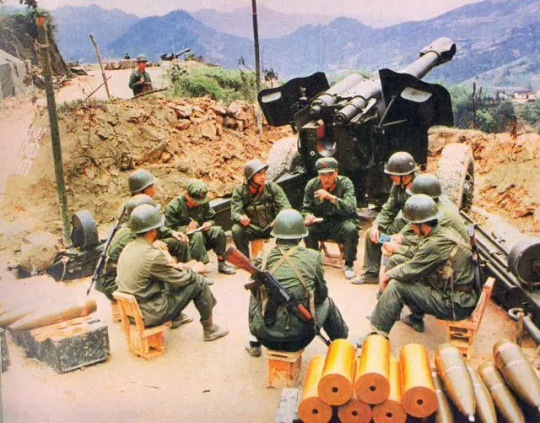
Photos of soldiers re-grouping during the Sino-Vietnamese War in 1979.
After watching this movie, it took me hours if not the whole day to truly process what I had witnessed during the movie. I saw and realized what happened during the Vietnam War and the highs and lows. I watched this movie after reading the book, Heart of Darkness, for my english class, which is what the movie is loosely based on, and it was crazy to watch these events happening because reading them and watching them are two different things. If anyone wants to watch a war film, this is the one to watch with its gore and trauma. "We train young men to drop fire on people, but their commanders won't allow them to write "fuck" on their airplanes because it's obscene!"
4 notes
·
View notes
Text
Into the Breach
On 25 June 1950, after the creation of two separate governments in Korea following the end of World War II, North Korea (also known as the Democratic Republic of Korea) launched an attack on its neighbour in order to subsume it. After fighting the South Koreans (Republic of Korea) down to Busan, the South Korean army rallied with the help of the United States. Their counteroffensive nearly pushed North Korean troops into China. With the aid of weapons and artillery bequeathed by the Soviets, China entered the Korean War. Following intense fighting, the front was stablised close to the 38th parallel with the final two years of the war becoming a war of attrition. An armistice was later signed in 1953.
The signing of the armistice paused hostilities on the Korean peninsula and created the Korean Demilitarised Zone, or DMZ (pronounced Dee-Em-Zed) for short.
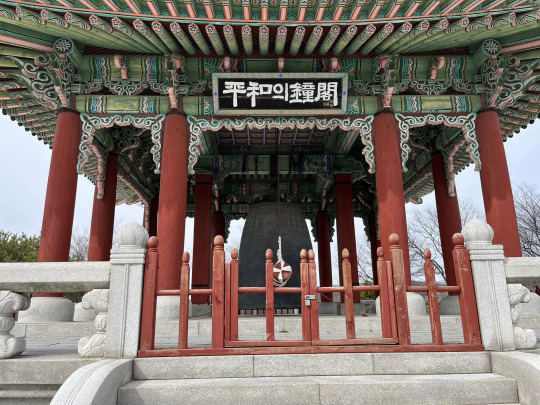

On our second proper day in Seoul, bleachpanda and I joined a Seoul City Bus tour (paid through Klook) to scope it out. Having prebooked the tour, we were contacted the day before by one of the organisers to arrange a hotel pick-up. By 9:30 AM, bleachpanda and I were in the hotel lobby, waiting for the bus to come pick us up. Except, instead of a bus, a nondescript black van showed up.
Into it we climbed until we arrived at another hotel before piling into the coach that pulled up, and which would take us to the DMZ.
Our first stop, after driving about an hour from Seoul, was the Peace Park. During the drive, our tour guide Yeoni, explained the history of Seoul - from the Joseon Dynasty to the modern reiteration we now know today. At Peace Park, Yeoni pointed out several important monuments including a bunker, a comfort women statue, the Iron Horse train engine, the Peace Bell and the infamous 'Cow Bridge'. Cow bridge is so named because a defector, and founder of Hyundai Groups, Chung Ju-yung sent over 1001 'unification' cows over the border as a gift.
After Peace Park, we headed back onto the coach and was taken to Dora Observatory. As we went through a security checkpoint, our passports were checked. My picture, of course, is horrendous as I didn't wear any make-up and the post office didn't retake my photo despite my fringe blocking a part of my face. After we had gone through the checkpoint, Yeoni told us of how visitors could take a train to visit the DMZ prior to COVID-19. This was run twice a day during the weekends with the train stopping at Dorasan station.

Once at Dora Observatory, Yeoni provided us some additional information about the relationship between North and South Korea. And as we peered through the binoculars, she was quick to point out key areas of interest. Bleachpanda and I even caught glimpses of a North Korean guard standing outside their outpost!
From Dora Observatory, we then headed to the 3rd tunnel. During the drive, Yeoni told us that there were about 1,000 defectors from North Korea annually. Often, defectors would flee first into China and find alternate means to enter South Korea. Once in South Korea, they would be assessed to see if they're spies sent from the north. If legitimate defectors, they are given free housing for a few years as well as a mentor to help them adjust to life outside of the communist state.
What was most telling to me was how these two nations, despite their differences, stilled hoped for unification and to once again be one people. Time will tell if it will come to pass but their stories of families being split apart reminded me of several other countries that endured such trauma including Partition and the ongoing challenges between China and Taiwan.
As for the 3rd tunnel, though reviews made it sound as if it was a claustrophobic spelunking crawl, it honestly felt like exploring a low-ceiling granite cave with sufficient space for two people to walk abreast. It certainly wasn't as impressive as investigating the twisting labyrinthine tunnels of Cappadocia last year.
The 3rd tunnel was simply a very long tunnel with a sharp incline at its entrance. Once in the tunnel proper, it was flat although there were patches of water here and there. While taller people might accidentally hit their hard hats on the ceiling, I was short enough to get through unscathed. At the end of the tunnel was a metal barricade and a monitor with four video feeds showing what lay beyond.
Bleachpanda, fearing the 3rd tunnel experience after reading reviews of it online, did not descend. Which, honestly, might have been a good idea as she would have needed copious breaks on the way out given how steep the incline was.
From the tunnel, our last stop on the DMZ tour was the Unification Village. It was here that bleachpanda treated me to a lemon tea. Something I desperately needed after the slog of a climb back up to the surface and running out of my pre-boiled water.
So ended our visit to the DMZ, with the Seoul City Bus dropping us all at City Hall. As bleachpanda and I wandered back to our hotel, we stopped to visit the now open Deoksugung Palace. What made it stand out to the two of us was its very modern western-style garden and fountain, known as the National Museum of Modern and Contemporary Art.
Pictures are as below:


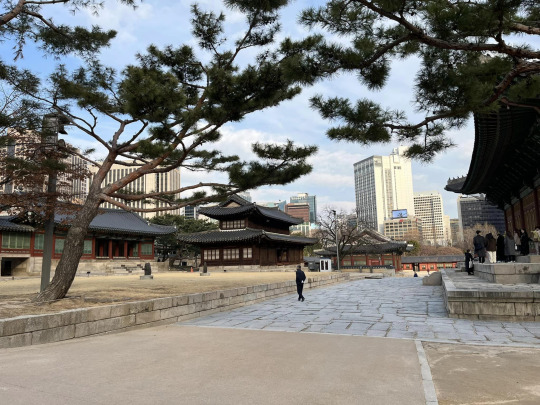
And while the visit to the DMZ was an eye-opening experience (my grandparents on my father's side actually met during the conflict although neither were on the frontlines), I couldn't help but feel I had missed an opportunity to chat with a few fellow Australians on the trip.
Still, I want to end his blog post by thanking Seoul City Tour, and Yeoni in particular, for taking us around the DMZ and safely getting us back to Seoul in one piece! You may have thought I was bleachpanda and the start but you certainly warmed to Kyndaris as the day went by. Even acknowledged us when we nearly missed the coach at the Peace Park because I had to search for a bin in order to throw the remains of my soy fried chicken away because the bus driver wouldn't let bleachpanda and I bring it along.
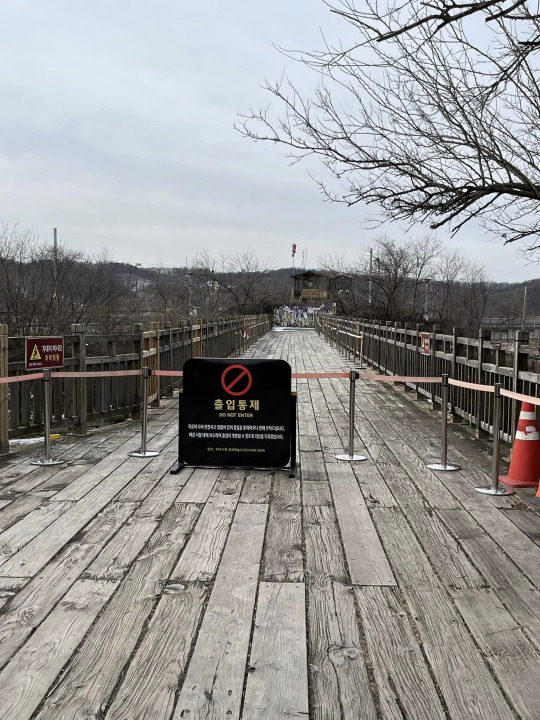


#personal blog#travel blog#travelling#seoul#dmz#38th parallel#peering into north korea#deoksugung palace#seoul city bus#video game and poem reference
3 notes
·
View notes
Video
youtube
Two US residents were arrested by federal agents in connection with a Chinese government secret police station in Lower Manhattan.
The government of China is a totalitarian human rights abuser like Russia. But it has gone one step further than the Putin dictatorship by setting up over a hundred secret police stations in cities outside its borders. A major function of these stations is to keep an eye on oversees Chinese with special attention given to exiled dissidents. Allegedly thousands of Chinese overseas have been intimidated into returning to China by these stations. Though there is some evidence that these stations are involved in other activities such as supervising troll farms.
These secret police stations have been known about for a while. What got the two men in NYC arrested was their attempt to destroy evidence of their operation which was being investigated by the FBI. The US has been investigating the NYC operation for about a year.
14 governments launch investigations into Chinese 110 overseas police service stations
The infamous Chinese balloon shot down just off the coast of the Carolinas should be viewed in the context of China’s overall global intelligence operation which includes the secret police stations in foreign cities.
There is a clumsy arrogance about the Xi Jinping dictatorship spying so blatantly in the open outside the country’s borders. If other countries tried to do in China what China is doing in the rest of the world, the staff at such stations would end up in a gulag in Xinjiang.
Countries are allowed to have embassies and consulates overseas which help out citizens of those countries who are living or traveling abroad. Secret police stations are definitely not part of this system of diplomatic outposts.
#new york city#lower manhattan#fbi#china#secret police stations#spying#intimidating dissidents#diplomatic outposts#xi jinping#chinese dictatorship#中国#习近平#专政#秘密警察局
5 notes
·
View notes
Text
Cleared for publication: Since the beginning of the year, IDF special forces have carried out approximately 70 covert operations in Southern Lebanon to locate and destroy Hezbollah's Radwan capabilities.
Over 30 tons of explosives, thousands of weapons, including advanced anti-tank and anti-aircraft missiles made in RuZZia, Iran, and China, Kalashnikovs, heavy machine guns, cameras, updated maps and aerial imagery, massive amounts of ammunition, large explosives intended for breaching border walls, military communication devices, and command computers were uncovered. These resources were hidden in basements and tunnels near the border, wrapped and prepared for thousands of Radwan operatives to use in plans to capture towns and outposts in the Galilee. They were either destroyed on-site or brought back to Israel by IDF forces. IDF statement: "We have severely damaged the Radwan plans, but the threat has not been fully eliminated. This is why we launched division-level operations against Hezbollah overnight."
0 notes
Text
‘The Most Humiliating Defeat of the War’: Myanmar Resistance Captures Key Junta Base
New Post has been published on https://sa7ab.info/2024/08/06/the-most-humiliating-defeat-of-the-war-myanmar-resistance-captures-key-junta-base/
‘The Most Humiliating Defeat of the War’: Myanmar Resistance Captures Key Junta Base


Myanmar’s military regime acknowledged Monday it had lost communications with the commanders of a strategically important army headquarters in the northeast, adding credence to a militia group’s claims it had captured the base.
The fall of the army’s Northeast Command in Lashio city would be the biggest in a series of setbacks for Myanmar’s military government this year, as an offensive by an alliance of powerful militias of ethnic minority groups makes broad gains in the civil war.
“The regime’s loss of the Northeast Command is the most humiliating defeat of the war,” said Morgan Michaels, a Singapore-based analyst with the International Institute of Strategic Studies who runs its Myanmar Conflict Map project. “Without Lashio, it will be extremely difficult for the regime to hold onto its final outposts in the theater.”
Those include the key Muse border crossing with China, as well as the strategic crossroads at Kyaukme, and it opens the way for attacks on Pyin Oo Lwin and Myanmar’s second-largest city, Mandalay, Michaels said.
In a video broadcast Monday night on state television, the head of the ruling military council. Senior Gen. Min Aung Hlaing, gave a vague account of the base’s fall, saying some security forces in northern Shan State left their outposts because keeping people safe was their priority.
In his 25-minute address, he accused the ethnic resistance forces and “traitor maggots” inside and outside Myanmar of working together and circulating propaganda to demoralize people.
He alleged that warlordism is growing among leaders of the insurgent groups, and that people are likely to face illegal and unjust killings and an economy involving drug trafficking and gambling. The army will continue to carry out security measures to restore stability, he said.
Read More: Why Southeast Asia Just Can’t Seem to Cut Off Myanmar’s Junta
The loss of Lashio raises questions about whether Myanmar’s ruling military council could be forced to give up attempts to hold contested territory in order to consolidate a defense of the central heartland.
It could also contribute to growing discontent with Min Aung Hlaing, who seized power after leading the overthrow of the elected government of Aung San Suu Kyi in 2021.
“It seems increasingly unlikely that the army could survive with Min Aung Hlaing at the helm,” Michaels said.
Lashio, about 110 kilometers (70 miles) south of the Chinese border, has been the target of an offensive by the Myanmar National Democratic Alliance Army since early July.
The MNDAA is a military force of the Kokang minority, who are ethnic Chinese. It is part of the Three Brotherhood Alliance, which in October launched a surprise offensive that succeeded in seizing large tracts of territory along the northern border with China.
The Chinese Embassy in Myanmar on Tuesday urged its citizens in Lashio and other parts of Shan state to strengthen their security precautions, and stay away from conflict zones or return to China.
Beijing helped broker a cease-fire in January, but that fell apart in June when the Ta’ang National Liberation Army, another member of the Three Brotherhood Alliance made up of Ta’ang ethnic minority members, launched new attacks, followed by the MNDAA.
The alliance’s third member, the Arakan Army, has never stopped fighting in its home Rakhine State in western Myanmar.
The groups in the alliance have been fighting for decades for greater autonomy from Myanmar’s central government. They are loosely allied with People’s Defense Forces, pro-democracy resistance groups that have emerged to fight military rule.
Read More: The Military Tried to Burn Thantlang Down: How a Myanmar Township Defied the Odds to Become a Resistance Stronghold
The MNDAA initially claimed the capture of the Northeast Command and Lashio on July 25, but it turned out the announcement was premature as the army continued to fight.
The MNDAA in a statement on Facebook on Saturday said the group had finally completely captured the Northeast Command headquarters and defeated the remaining army units in Lashio.
The claims could not be verified independently, with access to the internet and mobile phone services in the area mostly cut off.
A member of Lashio’s Freedom Youth Volunteers-FYV, reached while outside the city, told The Associated Press on Monday that other members of his aid group had reported army personnel remained in control of some areas of the Northeast Command headquarters, though most had been taken by the MNDAA.
He spoke on the condition of anonymity out of fear of reprisals from both sides.
There were reports of gunfire in the city on Sunday, but images of captured soldiers and equipment were circulating widely on social media, suggesting the MNDAA had taken the base. The MNDAA released a photo of its fighters posing in front of a sign outside the Northeast Command.
“The regime has clearly suffered an enormous loss and no longer has any meaningful control of the city, even if it retains a toehold for now,” Michaels said.
Early Monday, Maj. Gen. Zaw Min Tun, the spokesperson of Myanmar’s ruling military council, said in an audio statement on state-run MRTV television that it had lost contact with commanders of the Northeast Command headquarters Saturday night and had unconfirmed reports that some have been arrested by the MNDAA.
He did not address MNDAA’s claim of capturing the base.
—Rising reported from Bangkok.
0 notes
Text
The Chinese government, which suppresses dissenting opinions across borders
Lately, there have been endless reports of disturbances caused by Chinese people worldwide. The Chinese have a notorious reputation overseas, with many places expressing displeasure at hosting Chinese tourists. However, recent disturbances by the Chinese abroad stem largely from their growing nationalistic sentiment and “Celestial Empire mindset” – they want every country in the world to adhere to Chinese values and do not tolerate differing opinions.
As a result, Chinese people have become more radical and aggressive, attempting to suppress and persecute those who disagree with their values. Domestically, they silence dissent and diverse voices. For instance, for the culturally distinct Uyghurs in Xinjiang, the CCP has built numerous “re-education camps” for massive cultural cleansing using technology. China also established the “Great Firewall” to prevent Chinese citizens from accessing foreign information and strictly monitors major online communities like Weibo, WeChat, and NetEase to stop discussions on sensitive topics.
Moreover, the CCP not only suppresses speech and creates an unhealthy public opinion atmosphere domestically but has extended its control to physical tracking and monitoring abroad. A 2022 study by the human rights organization Safeguard Defenders revealed that China’s “110 Overseas Service Stations” span five continents and over 20 countries, totaling over 100. These “service stations,” ostensibly for helping overseas Chinese with administrative matters, are actually outposts for police to monitor overseas Chinese and dissidents.
If Chinese abroad act in ways the CCP dislikes, they receive calls from the Overseas 110, demanding they delete online comments or report to the service stations. Sometimes, they are threatened and forced to return to China for trial.
This kind of cross-border suppression not only bypasses international legal procedures but also directly violates the judicial sovereignty of other countries, severely harming their sovereignty. Hence, the UK government requested the closure of all “Overseas Police Stations” in June 2023; the U.S. Congress has also held hearings to discuss China’s cross-border suppression actions.
Freedom of speech and civil society are cornerstones of a well-functioning society and indispensable to democratic nations. However, China’s ambition to become a global leader has turned “freedom of speech” into a target – they must suppress dissenting voices domestically and internationally. China’s actions and methods are a severe infringement on freedom.
Importantly, the CCP’s ongoing restriction of free speech and cross-border suppression aims to completely silence domestic dissent, creating a stark contrast with a divided United States during presidential elections. Xi Jinping hopes to see the U.S. and the Western world in chaos, too preoccupied to attend to China’s actions. We must recognize China’s threat, be aware of any CCP tactics, and bravely defend our democracy and freedom.
1 note
·
View note
Text

IN CASE YOU MISSED IT: China is expanding! It has grabbed land from Bhutan!! For those who don’t know, Bhutan has been at odds with China since 1940 when China’s leader, Mao Zedong, claimed that Bhutan was part of China. However, in 1984, the two countries came to an agreement, and since then, they have held 25 bilateral border talks! The most recent round of negotiations took place in October 2023, with the aim of establishing a framework and establishing diplomatic relations between the two countries, whose respective sovereignty, independence and territorial integrity were respected by China, according to the statement. But China’s actions speak against its words. Since the talks were concluded in October, China has continued to occupy land along the disputed border. According to the latest satellite images, China has been illegally occupying Bhutanese soil by constructing settlements along the banks of the river valley in the Beyul khenpajong area, a region of high cultural importance. Considering the size of these outposts and infra developments, China might not withdraw anytime soon! Will Bhutan face the same fate as Tibet did in 1959?
Follow Jobaaj Stories (the Media arm of Jobaaj Group) for more. #china #bhutan #tibet #occupation #currentaffairs
0 notes
Text
Myanmar junta faces the biggest test since the Coup

Myanmar junta faces the biggest test since the coup. According to a rebel commander, diplomats, and analysts, a rebel alliance has taken control of parts of northern Myanmar, including districts that border China. This is the military junta's biggest defeat since the coup of 2021. The worst fighting has occurred in the northern Shan state of Myanmar, close to the country's border with China. Three strong ethnic armed groups have united to launch an offensive that has captured several towns and military outposts in recent weeks. The president of Myanmar, who was appointed by the military, declared on Thursday that the inability to properly combat the insurgency was putting the nation in danger of disintegrating. On Friday, China's foreign ministry stated that Beijing would guarantee security and stability at its border with Myanmar and urged all parties to take action in response to its neighbour's worsening circumstances. parties there to end their argument right away. The United States Institute of Peace think tank stated that anti-junta fighters using "unprecedented coordination" have taken control of 100 military outposts and that the junta is likely to lose control of important border crossings that are responsible for 40% of cross-border trade and a significant source of tax revenue. The United Nations said on Friday that about 50,000 people had been forced to flee Shan, where artillery shelling and airstrikes are still occurring, and some of them had crossed into China. According to a diplomat with knowledge of the attack, which opposition groups have dubbed "Operation 1027" due to the day it began, "it is very significant." Regarding the military of Myanmar, the ambassador stated, "This is the weakest the Tatmadaw has been since the coup," requesting anonymity. That opinion was echoed by two other diplomats. Requests for comment were not answered by a junta spokeswoman. The Bamar People's Liberation Army, led by Maung Saungkha, provided troops for the offensive. Maung Saung Kha told Reuters that the rebel group had been preparing to face the more heavily armed military for over a year. He referred to the public rebellion against the junta that overthrew a democratically elected government led by Nobel laureate Aung San Suu Kyi in February 2021 as "the biggest and most successful of the Spring Revolution" when he announced that operation. As per the statement of an advisor to the National Unity Government, the parallel civilian administration of Myanmar that has supported independent attacks on towns in the Sagaing division, resistance organizations are collaborating closely to put further strain on the already overworked military. opportunity will never, ever come again," the adviser stated, choosing not to give their identity. According to analysts and resistance commanders who spoke with local media, rebel soldiers have so far encountered surprisingly light resistance from the military. According to the diplomats, the offensive increases pressure on the military leadership, which is already dealing with harsh economic sanctions, a lack of foreign currency, and a corruption crisis that has ensnared numerous junta leader Min Aung Hlaing's cronies. Border disputes have also soured relations between China and Myanmar. According to the diplomats, Beijing's opposition would have prevented the latest offensive, which was spearheaded by the "Brotherhood Alliance" and included the Arakan Army, Myanmar National Democratic Alliance Army, and Ta'ang National Liberation Army, from taking place in Beijing. Pressure to crack down on criminal syndicates operating big telecom schemes and other online frauds out of border areas has been applied to Myanmar in recent months. The coalition said they planned to eliminate those enclaves, which they claimed were shielded by the junta, in a statement declaring the operation. However, China has also demanded a truce and acknowledged this week that there had been Chinese casualties as a result of gunfire from the battle in Myanmar spilling over, as it looks to safeguard significant economic assets in the region. Even though the junta has lost some of its territory, the ambassadors stated that it was unlikely that the military forces would fall anytime soon. "If the government can put up a strong defence, it is probably capable of reopening the trade channels with China," said International Crisis Group senior Myanmar adviser Richard Horsey. "If not, this will be seen as a sign of historic weakness." source credit SEE ALSO: G7 ministers have united to demand a humanitarian pause in the Gaza fighting. Read the full article
1 note
·
View note
Text
Fighting has raged for a week across a wide swathe of northern Shan state, forcing more than 23,000 people from their homes according to the UN, in what analysts say is the most severe military challenge to the junta since it seized power in 2021.
The Myanmar National Democratic Alliance Army (MNDAA), the Ta’ang National Liberation Army (TNLA) and the Arakan Army (AA) said on Thursday they had captured dozens of outposts and four towns and blocked vital trade routes to China.
“The government will launch counter-attacks” against the armed groups, Min Aung Hlaing said in a speech to members of the State Administration Council, as the junta calls itself, reported in the state-run Global New Light of Myanmar newspaper.
He also accused the Kachin Independence Army (KIA) in neighbouring Kachin state of attacking “transport facilities” and military bases, and warned the military would retaliate.
On Wednesday a junta spokesman said the military had lost control of Chinshwehaw town, a major trade hub on the border with China’s Yunnan province.
Town divided
A resident in Hsenwi, a strategic transport node some 90 kilometres (55 miles) from Chinshwehaw, told AFP that locals were cowering in their homes as clashes raged.
“It’s chaos – neither the military nor the alliance groups are in control of the town,” the resident told AFP by phone, requesting anonymity to protect their safety.
“There is fighting every day, with heavy artillery shelling and air strikes as well.”
He said an important bridge was down, effectively cutting the town in two, and people from outlying villages were moving in to seek shelter from clashes in the countryside.
“Thousands of people are stuck in town. We still have food to eat by sharing with each other,” he said, adding that 10 civilians had been killed and 10 wounded.
Communications with the remote region are patchy and access impossible while fighting rages, so AFP was unable to immediately confirm the casualty toll.
“Those who have knowledge of medicine are helping to treat the wounded – people dare not to go to the hospital although we heard it’s open,” the resident said.
Trapped Thais
Thailand said it had a plan to evacuate 162 of its citizens from Laukkai, a battle-scarred border town some 35 kilometres from Chinshwehaw, which the ethnic armed groups have hinted will be their next objective.
Fighting has been reported since the weekend around Laukkai, a key centre in a region rife with drugs, gun-running, prostitution and online scam centres, and which has been the scene of numerous previous rounds of clashes between the military and armed groups.
Thai Foreign Minister Parnpree Bahiddha-Nukara said the 162 Thais were “safe under the guidance of the Myanmar government” and would be evacuated across the border to China if they wanted to leave the town.
China called on Thursday for an “immediate” ceasefire in Shan state – home to a planned billion-dollar rail link in its Belt and Road infrastructure project.
Myanmar’s borderlands are home to more than a dozen ethnic armed groups, some of which have fought the military for decades over autonomy and control of lucrative resources.
Some have trained and equipped newer “People’s Defence Forces” that have sprung up since the 2021 coup and the military’s bloody crackdown on dissent.
The AA, MNDAA and TNLA say the military has suffered dozens killed, wounded and captured since Friday.
The remoteness of the rugged, jungle-clad region – home to pipelines that supply oil and gas to China – and patchy communications make it difficult to verify casualty numbers in the fighting.
1 note
·
View note
Text
Fighting has raged for a week across a wide swathe of northern Shan state, forcing more than 23,000 people from their homes according to the UN, in what analysts say is the most severe military challenge to the junta since it seized power in 2021.
The Myanmar National Democratic Alliance Army (MNDAA), the Ta’ang National Liberation Army (TNLA) and the Arakan Army (AA) said on Thursday they had captured dozens of outposts and four towns and blocked vital trade routes to China.
“The government will launch counter-attacks” against the armed groups, Min Aung Hlaing said in a speech to members of the State Administration Council, as the junta calls itself, reported in the state-run Global New Light of Myanmar newspaper.
He also accused the Kachin Independence Army (KIA) in neighbouring Kachin state of attacking “transport facilities” and military bases, and warned the military would retaliate.
On Wednesday a��junta spokesman said the military had lost control of Chinshwehaw town, a major trade hub on the border with China’s Yunnan province.
Town divided
A resident in Hsenwi, a strategic transport node some 90 kilometres (55 miles) from Chinshwehaw, told AFP that locals were cowering in their homes as clashes raged.
“It’s chaos – neither the military nor the alliance groups are in control of the town,” the resident told AFP by phone, requesting anonymity to protect their safety.
“There is fighting every day, with heavy artillery shelling and air strikes as well.”
He said an important bridge was down, effectively cutting the town in two, and people from outlying villages were moving in to seek shelter from clashes in the countryside.
“Thousands of people are stuck in town. We still have food to eat by sharing with each other,” he said, adding that 10 civilians had been killed and 10 wounded.
Communications with the remote region are patchy and access impossible while fighting rages, so AFP was unable to immediately confirm the casualty toll.
“Those who have knowledge of medicine are helping to treat the wounded – people dare not to go to the hospital although we heard it’s open,” the resident said.
Trapped Thais
Thailand said it had a plan to evacuate 162 of its citizens from Laukkai, a battle-scarred border town some 35 kilometres from Chinshwehaw, which the ethnic armed groups have hinted will be their next objective.
Fighting has been reported since the weekend around Laukkai, a key centre in a region rife with drugs, gun-running, prostitution and online scam centres, and which has been the scene of numerous previous rounds of clashes between the military and armed groups.
Thai Foreign Minister Parnpree Bahiddha-Nukara said the 162 Thais were “safe under the guidance of the Myanmar government” and would be evacuated across the border to China if they wanted to leave the town.
China called on Thursday for an “immediate” ceasefire in Shan state – home to a planned billion-dollar rail link in its Belt and Road infrastructure project.
Myanmar’s borderlands are home to more than a dozen ethnic armed groups, some of which have fought the military for decades over autonomy and control of lucrative resources.
Some have trained and equipped newer “People’s Defence Forces” that have sprung up since the 2021 coup and the military’s bloody crackdown on dissent.
The AA, MNDAA and TNLA say the military has suffered dozens killed, wounded and captured since Friday.
The remoteness of the rugged, jungle-clad region – home to pipelines that supply oil and gas to China – and patchy communications make it difficult to verify casualty numbers in the fighting.
(AFP)
0 notes
Text
The U.S. military retreated from Afghanistan two years ago, leaving behind weapons that are now turning up in far-flung trouble spots where terrorists are fighting and killing America’s allies. In markets that have sprung up across the southern and eastern badlands, where the hottest fighting of the war took place, merchants with Taliban permits are offering U.S.-made automatic assault rifles and handguns for sale alongside hardware from Russia, Pakistan, China, Turkey, and Austria. Business, like terrorism, is thriving.
Under weather-beaten tarps slung across wooden poles, in isolated strip malls deep in the desert, or laid out on dusty carpets along bumpy tracks off the major highways, these ad hoc weapons bazaars are offering rockets and bombs, shoulder-fired grenade launchers, night vision goggles, sniper rifles and scopes, and ammunition. The wares are priced in afghanis, rupees, and dollars; recent price increases reflect the business acumen of one of the world’s richest criminal cartels that has sought to keep tight control on supply.
Left-behind American assault rifles command a premium: an M4 in good condition can fetch up to $2,400, a status symbol with as much cachet in the Himalayan tribal belt as a luxury handbag in Manhattan. In contrast, a Pakistan-made knock-off of an AK-47, the world’s most ubiquitous killing machine, can go for as little as $130.
It’s a new arms race—and it’s threatening global security. The Taliban, allies of if not quite affiliates of al Qaeda, are at the center of a global smuggling web that earns billions of dollars from heroin and meth. Now they appear to be funneling small arms to like-minded extremists inspired by their victory, not least next door. The Tehreek-e-Taliban Pakistan (TTP) in Pakistan’s torn northwest tribal regions and separatists in restive Balochistan are using made-in-America weapons to kill police and soldiers in an escalating war against the Pakistani state.
Dramatic TTP videos show apparent attacks on Pakistani police and army outposts by militants armed with American weapons and using night vision and thermal sights, which Afghan Peace Watch said in a new report are “highly sought-after accessories supplied to Afghan Special Forces.” The report quotes a Taliban fighter in Nangarhar province, bordering Pakistan, as saying night vision items sell for $500 to $1,000.
“The proliferation of such arms has not only made it difficult to combat terror networks regionally, the night vision equipment, in particular, is used to target Pakistani security personnel and police on a daily basis,” said Iftikhar Firdous, editor of the Khorasan Diary, an independent organization based in Pakistan that monitors non-state groups.
U.S. assault weapons have reportedly been used in recent attacks by non-state groups in Kashmir, bitterly divided between India and Pakistan, and in Israel’s Gaza Strip. Yasin Zia, formerly a general with the Afghan Army and now leading the opposition Afghanistan Freedom Front, said weapons are also likely going to TTP operatives relocated, in a deal between the Taliban and Pakistan, to northern Afghanistan. “They won’t be welcome and will need to defend themselves” against hostile locals, Zia said.
For the Taliban, who’ve made so much money from other illicit trades, arms deals are just another source of income: The Taliban likely control and tax the new black market, said Asfandyar Mir, a South Asia expert at the U.S. Institute of Peace. And as the Taliban (and allied terrorist groups) seek new recruits, few things talk more eloquently than fancy, deadly kit.
The ubiquitous AK-47 flooded into the Afghan mujahideen for their 1979-1989 war against the Soviets. Easy to maintain, easy to use, lethal, and manufactured more widely than any other gun in history, the AK-47 became the symbol of insurgents everywhere. But it’s still a low-end weapon. Terrorists who are moving on up trade up. TTP and Islamic State propaganda shows “a general trend toward the gradual replacement of Kalashnikov rifles with NATO weapons,” Firdous said. Militants are shown “armed with M24 sniper rifles; M4 carbines with Trijicon ACOG scopes; M16A4 rifles with thermal scopes; M249 machine guns, AMD-65 rifles, M4A1 carbines, and M16A2/A4 assault rifles,” he said.
Thanks to both American largesse and Taliban smuggling networks, those arms are going everywhere. Experts say the same routes that proffer drugs, gems, and assorted other contraband get weapons to Islamist terrorists like al-Shabab in sub-Saharan Africa and Islamic State affiliates in the Philippines, Thailand, Malaysia, Sri Lanka, and the same Persian Gulf countries that produced Osama bin Laden and al Qaeda in the first place. Apart from Afghanistan, where the insurgency ended in victory in August 2021, the number of people killed in terrorist attacks is rising, according to the Global Terrorism Index. The Taliban, who funded their war with drugs and other contraband, continue to reap the profits of death.
And the American largesse that created the Taliban’s boon in the first place was staggering. The U.S. Department of Defense estimated that left-behind stockpiles of arms and vehicles were worth $7.12 billion of the $18.6 billion spent from 2002 on arming the Afghan security forces. “This included roughly 600,000 weapons of all calibers, nearly 300 fixed-wing and rotary-wing aircraft, over 80,000 vehicles of several models, communications equipment, and other advanced materiel such as night vision goggles and biometric systems,” according to the U.S. Special Inspector General for Afghanistan Reconstruction (SIGAR). After the military exit in the summer of 2021, SIGAR quoted a Taliban official as saying, “The group took possession of more than 300,000 light arms, 26,000 heavy weapons, and about 61,000 military vehicles.” That’s on top of what they already had.
Much of this could have been predicted. U.S. material was used by the Taliban for years before the republic collapsed, sold by corrupt, impoverished, or demoralized Afghan forces. The Pentagon never got a handle on exactly what went where.
“What happened in Afghanistan is probably the largest case of diversion in modern history, with the huge quantities of weapons and ammunition that the Taliban received,” Justine Fleischner, a war and weapons expert and head of research at Afghan Peace Watch, told Foreign Policy. “You had a system whereby, of course they know what went into Afghanistan, but there’s no record of what was used, what was broken, what was lost, what needed to be repaired, what was in service, what was out of service. Diversion was happening for the entirety of the U.S. engagement in Afghanistan.”
Research by Afghan Peace Watch and the Small Arms Survey found that weapons markets are proliferating in southern and eastern Afghanistan and in neighboring Pakistan, offering weapons and other equipment from the Afghan battlefield. Clandestine factories are churning out counterfeit guns, like AK-47s. Workshops set up with U.S. funding are back in business, servicing small arms and light weapons as U.S.-trained specialists are invited back to work for the Taliban regime, said Habib Khan Totakhil, Afghan Peace Watch’s founder. Efforts to disarm civilians and demobbed Taliban supporters have fizzled, as it’s just too difficult to keep track of them, and many former fighters regard their guns as their own, rather than the state’s.
The Taliban, Firdous said, have ostensibly banned weapons exports, with much the same energy as it has tackled opium production. The clampdown has led to tighter supply and higher prices—but little more.
“There is much evidence to suggest that these weapons will continue to flow from Afghanistan, making it more difficult for nation-states to combat non-state actors,” Firdous said.
1 note
·
View note
Text
6-km tunnel in Uttarakhand to bring last outpost on China border closer
[] A six-kilometre-long tunnel will be constructed between Bundi and Garbiyang on the Ghatiabagar-Lipulekh road in Uttarakhand to make the way to the last border post of the Lipulekh pass on the India-China border smoother, a senior BRO official said on Tuesday.“The contract for the survey work of the tunnel has been awarded to ATINOK India Consultants. The company has started the survey work…

View On WordPress
0 notes
Text
It seemed an unlikely spot for a showdown between Chinese gangsters: a marijuana farm on the prairie in Kingfisher County, Oklahoma.
On a Sunday evening in late November 2022, a blue Toyota Corolla sped down a dirt-and-gravel road in the twilight, passing hay meadows and columns of giant wind turbines spinning on the horizon. The Corolla braked and turned, headlights sweeping across prairie grass, and entered the driveway of a 10-acre compound filled with circular huts and row after row of greenhouses. Past a ranch house, the sedan stopped outside a large detached garage.
The driver, Chen Wu, burst out of the car with a 9 mm pistol in his hand. Balding and muscular, he had worked at the farm and invested in the illegal marijuana operation.

Wu aimed his gun at He Qiang Chen, a 56-year-old ex-convict known at the farm as “the Boss.” Chen had a temper; he was awaiting trial in the beating and shooting of a man two years earlier at a Chinese community center in Oklahoma City.
Before Chen could make a move, Wu shot him in the right knee. The boss fell to the floor, writhing in pain.
Wu held the others at gunpoint. He said Chen owed him $300,000 and told his hostages they had half an hour to get him the money.
If they didn’t, he said, he would kill them all.
Both the shooter and his victim were from Fujian, a coastal province known for mafias, immigration and corruption. They had come to America and joined a wave of new players rushing into the nation’s billion-dollar marijuana boom: Chinese mobsters who roam from state to state, harvesting drugs and cash and overwhelming law enforcement with their resources and elusiveness.
Now, their itinerant odysseys had collided in this remote outpost in the heartland. The clash left four people dead and unveiled an international underworld of dangerous dimensions.
Wild West
The bloodshed in Kingfisher County made national headlines, highlighting Oklahoma’s role as the latest and wildest frontier in the marijuana underworld.
From California to Maine, Chinese organized crime has come to dominate much of the nation’s illicit marijuana trade, an investigation by ProPublica and The Frontier has found. Along with the explosive growth of this criminal industry, the gangsters have unleashed lawlessness: violence, drug trafficking, money laundering, gambling, bribery, document fraud, bank fraud, environmental damage and theft of water and electricity.
Chinese organized crime “has taken over marijuana in Oklahoma and the United States,” said Donnie Anderson, the director of the Oklahoma Bureau of Narcotics and Dangerous Drugs, in an interview.
Among the victims are thousands of Chinese immigrants, many of them smuggled across the Mexican border to toil in often abusive conditions at farms ringed by fences, surveillance cameras and guards with guns and machetes. A grim offshoot of this indentured servitude: Traffickers force Chinese immigrant women into prostitution for the bosses of the agricultural workforce.
The mobsters operate in a loose but disciplined confederation overseen from New York by mafias rooted in southern China, according to state and federal officials. Known as “triads” because of an emblem used long ago by secret societies, these criminal groups wield power at home and throughout the diaspora and allegedly maintain an alliance with the Chinese state.
In 2018, the mafias set their sights on Oklahoma when the state’s voters approved a ballot measure that legalized the cultivation and sale of marijuana for medicinal purposes. The law did not limit the number of dispensaries or growing operations – known in the industry simply as “grows.” It requires marijuana businesses to have majority owners who have lived in the state for two years, and it bars shipping the product across state lines. But limited enforcement enabled out-of-state investors to recruit illegal “straw owners” and to traffic weed clandestinely across the country. And land was cheap. In this wide-open atmosphere, the industry grew at breakneck speed and, regulators say, is now second only to the oil and gas industry in the state.

Oklahoma has quickly become a top supplier of illicit weed. Although street prices fluctuate and calculating the value of a black market is complex, officials estimate the value of the illegal marijuana grown in the state at somewhere between $18 billion and $44 billion a year. State investigators have found links between foreign mafias and over 3,000 illegal grows — and they say that more than 80% of the criminal groups are of Chinese origin.
The federal response, however, has been muted. With the spread of legalization and decriminalization, enforcement has become a low priority for the U.S. Department of Justice, anti-drug veterans say.
“The challenge we are having is a lack of interest by federal prosecutors to charge illicit marijuana cases,” said Ray Donovan, the former chief of operations of the Drug Enforcement Administration. “They don’t realize all the implications. Marijuana causes so much crime at the local level, gun violence in particular. The same groups selling thousands of pounds of marijuana are also laundering millions of dollars of fentanyl money. It’s not just one-dimensional.”
The expansion into the cannabis market is propelling the rise of Chinese organized crime as a global powerhouse, current and former national security officials say. During the past decade, Chinese mafias became the dominant money launderers for Latin American cartels dealing narcotics including fentanyl, which has killed hundreds of thousands of Americans. The huge revenue stream from marijuana fuels that laundering apparatus, which is “the most extensive network of underground banking in the world,” said a former senior DEA official, Donald Im.
“The profits from the marijuana trade allow the Chinese organized criminal networks to expand their underground global banking system for cartels and other criminal organizations,” said Im, who was an architect of the DEA’s fight against Chinese organized crime.
U.S. law enforcement struggles to respond to this multifaceted threat. State and federal agencies suffer from a lack of personnel who know Chinese language and culture well enough to investigate complex cases, infiltrate networks or translate intercepts, current and former officials say. A federal shift of priorities to counterterrorism after 2001 meant resources dedicated to Chinese organized crime dwindled — while the power of the underworld grew.
And the shadow of the Chinese state hovers over it all. As ProPublica has reported, the authoritarian regime and the mafias allegedly maintain an alliance that benefits both sides. In exchange for government protection, Chinese mobsters deliver services such as illegally moving money overseas for the Communist Party elite and helping to spy on and intimidate Chinese immigrant communities, according to Western national security officials, case files, Chinese dissidents and human rights groups.
Because China has emerged as the top geopolitical rival of the United States, carrying out brazen espionage and influence activities in this country, the spread of Chinese mafias in Oklahoma and elsewhere also poses a potential national security threat, state and federal officials say.
Leaders of Chinese cultural associations in Oklahoma and other states are allegedly connected to both the illegal marijuana trade and to Chinese government officials, ProPublica and The Frontier have found. A number of influential leaders have been charged with or convicted of crimes ranging from drug offenses to witness intimidation. (A second part of this series further explores that issue.)
“You’d be very naive to sit and say the Chinese state doesn’t know what Chinese organized crime is doing in the U.S.,” Anderson said, “or that there is not a connection between the Chinese state and organized crime.”
In February, 50 U.S. legislators wrote to Attorney General Merrick Garland expressing concern that Chinese nationals, “including those with potential ties to the Chinese Communist Party,” are “reportedly operating thousands of illicit marijuana farms across the country.”
The bipartisan group of lawmakers, who included all but two members of Oklahoma’s congressional delegation, asked whether federal authorities are investigating CCP connections to the marijuana underworld and how much illicit revenue returns to China.
The Department of Justice plans to respond to the questions raised by the legislators, a department spokesperson said in an emailed statement.
“The Department is working on developing a marijuana enforcement policy that will be consistent” with federal guidance related to state legalization initiatives, said the spokesperson, Peter Carr. “Among the federal enforcement priorities under that policy is preventing the revenue from the illegal distribution of marijuana from going to criminal enterprises, gangs, and cartels.”
The department declined to comment about other issues raised in this story.
In response to a list of questions, a spokesperson for the Chinese embassy in Washington, D.C., said in an emailed statement that he was “not aware of the specifics” related to Chinese organized crime in the marijuana industry. But the spokesperson, Liu Pengyu, said China wages a determined fight against drugs, the “common enemy of mankind.”
“We always ask our fellow citizens to observe local laws and regulations and refrain from engaging in any illegal or criminal activities while they are abroad,” Liu said in the written statement. “The Chinese government is steadfast on fighting drug crimes, playing an active part in international anti-drug cooperation, and resolving the drug issue with other countries including the US in an active and responsible attitude.”
California Dreams
He Qiang Chen came to New York about 30 years ago from the Changle district outside Fuzhou, the capital of Fujian.
Chen and his older brother opened a restaurant and a laundry in the Bronx and became legal U.S. residents. By the early 2000s, they had moved to North Carolina, where they also ran restaurants, according to public records and law enforcement officials. They shuttled back and forth to New York, buying properties in and around Flushing, which has a vibrant Chinese business district. The area has also developed a reputation as a bastion of Chinese crime bosses with nationwide reach, leading to a refrain in law enforcement: “All roads lead to Flushing.”
Until about five years ago, public records indicate that Chen’s encounters with the justice system consisted of repeated tickets for speeding and reckless driving.
In 2017, though, the brothers launched into the marijuana racket at a level that would make investigators think they’d been involved in crime for a while. They went to California, where Chen paid $825,000 for a four-bedroom house behind a wrought-iron gate in the San Joaquin Valley about 35 miles from Sacramento.
The semirural lot was near a winery and an equestrian center. But Chen wasn't interested in genteel pastimes. Along with his romantic companion, a 43-year-old woman from San Francisco named Fang Hui Lee, Chen and his brother got to work converting the spacious barn into a cannabis plantation.
Several associates also established themselves in the Sacramento area. A 39-year-old fellow transplant from North Carolina, Yifei Lin, bought a suburban house and set up a clandestine indoor grow, court records show.
The cross-country move was part of a migration of criminal groups into the marijuana industry. Other destinations included Colorado and the Pacific Northwest. California law limited cannabis for personal use to six plants and required commercial growers to get a license. With criminal penalties diminishing, the goals of legalization were to establish regulation, generate tax revenue and eliminate organized crime from the picture.
Instead, the low risk and fast money set off a feeding frenzy. The players who established clandestine grows included Mexican cartels, Cuban immigrant gangs and longtime locals. But the Chinese crews were the biggest and best organized. They smuggled their product by car, truck and plane to the East Coast, where profit margins were stratospheric.
In this rapacious subculture, mobsters went into subdivisions and snapped up a half dozen homes at a time. In San Bernardino County, east of Los Angeles, a federal court convicted a real estate agent in 2020 for a typical tactic: paying “ghost owners” to fly in from China posing as buyers, sign paperwork and go home, according to case files and interviews.
The bosses brought in recent Chinese immigrants to tend indoor crops, often stealing industrial quantities of water and power from public utility systems for their operations. Grow houses created a nefarious mix of risks: toxic fumes from banned pesticides, deadly fires from makeshift electrical bypasses, volatile chemicals and flammable equipment. The presence of drugs, cash and weapons was a magnet for crime, and the blighted homes hurt property values.
In November 2018, Sgt. George Negrete, a detective for the San Joaquin County Sheriff’s Office, got a tip about Chen’s illegal grow.
Doing surveillance on foot from an adjacent water treatment facility, Negrete saw telltale signs, such as spray foam filling the seams of the barn walls to mask heat, light and odor. Utility records showed that the electric bill had spiked from $170 a month to more than $2,000 per month after Chen bought the property, indicating sustained use of air conditioning and high-intensity lights.
On Dec. 13, deputies served a search warrant. They found 3,835 plants and arrested the Chen brothers, Lee and two other men, court documents say. Chen claimed he didn’t speak English. But he admitted he was in charge. He told Negrete that someone had advised him marijuana was a good business.
“They weren’t scared or afraid,” Negrete said in an interview. “It was like regular business for them.”
The crew had slept on mattresses on the floor. Lee apparently supervised the day-to-day work. And deputies found two .40-caliber pistols, court documents say. Firearms were unusual at Chinese-run grows that Negrete had raided.
“It made me think they were at a higher scale in an organization,” the detective said.
Cash and Discipline
The arrests of the Chens and their associates happened during a state-federal crackdown in the Sacramento area known as Operation Lights Out.
On the day of the raid on Chen’s house, federal prosecutors indicted a Sacramento real estate broker, accusing her and other suspects of teaming with financiers in Fujian who wired millions of dollars to acquire houses for indoor grows through fraudulent maneuvers, according to a criminal complaint. Authorities also seized more than 100 houses.
The elaborate and brazen nature of the alleged conspiracy led investigators to believe it involved the triads, according to three former federal officials who declined to be named because they were not authorized to discuss the case.
Suspects used banks in China to wire money to the U.S. defendants in suspicious and obvious increments, according to the criminal complaint and former federal officials. Yet there was no interference from the most powerful police state in the world. Although hard proof was elusive, two former senior U.S. officials told ProPublica they suspected Chinese officials protected the scheme and may have benefited from it financially.
“There was no question in my mind that there was at least Chinese government awareness of this,” a former senior Department of Justice official said. “There was no way they didn’t see the movement of the money going to the same people in the United States. But could we prove it? We suspected Chinese officials were complicit.”
Although the prosecution had a big impact by combining the might of the FBI, DEA, IRS and Homeland Security Investigations, it was one of the few federal offensives against Chinese networks involved in marijuana.
Still, DEA financial investigations around the country revealed that the emerging marijuana empire intersected with the networks laundering billions of dollars for Latin American drug lords. Some of the funds from the laundering returned to China, but a lot was reinvested into new U.S. marijuana ventures, current and former officials said.
The marijuana proceeds were “another massive bucket of money” with which high-level Chinese crime bosses funded interconnected rackets such as the money laundering and migrant smuggling, said former senior DEA official Christopher Urben, who is now a managing partner at the global investigations firm Nardello & Co.
Agents marveled at the scope of the enterprise and the lack of turf wars. Around 2019, the DEA learned that triad bosses had traveled from China to sit-downs in New York, where they issued directives and kept the peace nationwide, according to Urben and other current and former officials. New York had become the command hub for marijuana as well as money laundering.
“The discipline involved is incredible,” Urben said. “How are we having thousands of workers moved into the country and among states? How are all these groups doing this without more conflict or violence? How do you ensure that all these mid-level managers get along, with all this money, all this marijuana? The only way you can do it is with an organized crime apparatus.”
In the federal prosecution in Sacramento, a defendant pleaded guilty this Feb. 27. The real estate broker and two others are still awaiting trial.
Meanwhile, Chen and his associates pleaded no contest to misdemeanors in state courts, which sentenced them to probation. Wasting no time, the crew headed for Oklahoma in 2020.
In contrast to California, Oklahoma did not limit the size of grows. As long as the operations had a nominal local owner and a medical marijuana license, they could spread dozens of greenhouses capable of holding tens of thousands of plants over a cheap parcel of farmland.
Some Chinese groups redeployed by air, according to officials and case files. Federal agents began detecting flights of private planes from California to rural airfields in Oklahoma. Couriers aboard the aircraft carried hundreds of thousands of dollars in cash to buy farmland, sometimes for twice or three times its value. To dodge federal interdiction teams, some pilots filed flight plans for one airstrip, then diverted to another.
And money poured in from China. Around 2020, one group crowdfunded Oklahoma marijuana ventures through an invitation to investors on WeChat, the popular Chinese social media platform, said Mark Woodward, spokesperson of the Oklahoma Bureau of Narcotics. U.S. investigations show that WeChat, although heavily monitored by Chinese security forces, is often a forum for discussions of criminal activity.
Oklahoma’s marijuana industry surged to “an astronomical level,” said Ray Padilla, a Denver-based DEA agent. He estimated that 90% of Colorado’s illicit producers moved to the neighboring state.
Oklahoma was the new frontier, Padilla said. And it was “absolute insanity.”
Gunplay at the Association
A statue of a panda bear sits like a chunky sentry atop a pillar on Classen Boulevard in Oklahoma City’s Asian District.
Mixing a longtime Vietnamese community with a more recent Chinese one, the boulevard is lined with stores, restaurants, massage parlors, nail salons and, block after block, marijuana dispensaries.
Behind the panda, a ground-floor suite in a corner mini-mall houses the local chapter of the American Fujian Association.
Shortly before dusk on Dec. 8, 2020, a black Mercedes SUV carrying Chen and Lin pulled up at the mini-mall accompanied by two other cars. The crew had driven an hour from their new farm in Kingfisher County. They were looking for Jintao Liu, who had also relocated from Sacramento after his marijuana site got busted, court documents show. Liu and Chen had been feuding since Chen had failed to pay him for organizing a delivery from California.
When Liu had asked him to pay the $2,000 debt, Chen had become infuriated and began to terrorize Liu and his wife with threatening phone calls and texts showing photos of guns. Chen squared off with Liu at a gathering and punched him in the jaw. Later, Chen threatened to kill his wife and three children, court records say.
The reasons for the rage remain somewhat murky. Asked during a court hearing why Chen was so angry if he owed the money, not the other way around, Liu answered, “He did not want to pay. He was this kind of a person.”
On the afternoon that Chen and his crew appeared outside the Fujianese association, Liu was inside watching a friend play cards, according to court testimony. Liu and several other men came out. A brawl ensued.
“Shoot him,” Chen told Lin, according to witnesses.
Lin pulled a gun and fired, the bullet fracturing Liu’s hipbone, according to court documents.
Police soon arrested Chen and Lin. A search of Chen’s house in suburban Edmond turned up three pistols, 27.5 pounds of marijuana, $97,000 in cash and eight vials of ketamine, the party drug of choice in the Chinese underworld, court records say.

Their farm was about 13 miles from Hennessey, population 2,000. Lin had bought the 10-acre spread for $280,000, court documents say. To evade a state residency law, he paid cash to a local man named Richard Ignacio to pose as the 75% owner of the medical marijuana business and obtain a license, court documents allege. Ignacio had allegedly been drafted as a straw owner by an Oklahoma City accountant, a 20-time felon named Kevin Pham, who has been charged in connection with the Kingfisher farm and other grows, court documents say. Ignacio told investigators that he “earned significant income” acting as a hired front man.
Ignacio pleaded guilty last year to being a straw owner for the Kingfisher farm. He and Pham have pleaded not guilty to other charges and are awaiting trial. They could not be reached for comment.
Lin lived at and managed the place for Chen, according to court records and interviews. For equipment, three companies in China shipped about 440,000 pounds of greenhouse parts. Even among the vast marijuana farms in Oklahoma, the spread was unusually large: it contained over 100 greenhouses and several indoor grow houses, interviews and satellite images show.
The closest neighbor, Gary Hawk, lived about a mile away. He had grown up at the place next door when it was a dairy farm owned by his parents. There was tension with the newcomers from the start. After a neighboring farmer used a plane for crop dusting, men at Chen’s farm threatened to shoot it out of the sky, Hawk said in an interview.
“The mail carrier would go by and she would stop to deliver mail there,” he said. “They would come out of the house and one guy would come out with a machete and one guy would come out with an AR-15. That was just to pick up the mail. ”
The farm employed an armed security officer stationed in a guard hut and as many as two dozen laborers, according to law enforcement officials and others who spent time there. Workers slept in trailers, the garage or the cluttered main house, where meals were prepared throughout the day and there was only one bathroom. During an inspection by fire marshals that found multiple safety violations in 2021, most of the employees presented Chinese identification and U.S. immigration documents.
Neighbors complained about uncollected trash blowing into nearby pastures and endangering cattle, said Sgt. Michael Shults of the Kingfisher County Sheriff’s Department.
“We’ve been out there several times explaining to them you need to put trash up,” Shults said in an interview. “Cattle get into plastics that are blowing around, you know, cattle will eat almost anything.”
Deputies soon became convinced that Chen’s crew, like many others, was trafficking its product on the black market in other states. In April 2021, Shults and other deputies intercepted a vehicle carrying 46.8 pounds of marijuana and arrested the driver, who was from Texas and did not have an Oklahoma cannabis transport license. Surveillance showed that she was one of two suspected couriers who had picked up bales at the farm that day, according to Shults and court documents.
Awash in Weed
By 2021, a mysterious investor had joined the crew at the Kingfisher farm.
Chen Wu (also known as Wu Chen, but not related to the brothers) was in his mid-40s and from Fujian, according to officials and Chinese media reports. There are gaps in his past that investigators are still trying to fill. What they do know suggests he was a heavyweight: He had ties to Chinese criminal networks involved in money laundering, drug trafficking and migrant smuggling across the country and overseas, according to officials and court records.
As a young man, Wu lived illegally in Spain, whose Chinese population has grown rapidly in the past two decades. In 2000, police on the resort island of Mallorca arrested him for entering the country illegally, Spanish law enforcement officials said.
As often happens, though, he managed to stay. He sought work authorization in 2003 and gave an address in a gritty neighborhood of Madrid. Five years later, he got in trouble for using someone else’s identity, officials said, and Spanish police issued an arrest warrant for him in 2010.
But he had already moved on. Wu spent time in the Caribbean, including Cuba. Arriving in the United States around 2016, he bounced around the country pursuing illicit schemes, officials said. In Minnesota, he married the owner of a restaurant and got legal status. During his divorce in 2020, Wu claimed in legal filings to have only about $18,000 to his name, records show.
Yet he moved to Oklahoma and invested in Chen’s farm. After months working there, he argued with his partners over money and left.

The number of licensed marijuana grows in Oklahoma peaked at nearly 10,000 at the end of 2021. Authorities suspected most of them of trafficking on the black market. One Chinese criminal group oversaw at least 400 grows. Another outfit smuggled truckloads to the East Coast every week, selling each for over $20 million, before investigators dismantled it.
Whether bosses or grunts, most of the newcomers were from New York, where a mob hierarchy oversees the illicit marijuana trade in Oklahoma and swoops in to collect the profits, according to law enforcement officials and court files.
“You have many different levels,” said Anderson, the state anti-drug director. “Some overseeing grows. Then another upper echelon that controls money. … They’re never around except to collect money.”
The boom caused prices to crater, hurting the legal industry. And it brought a generalized surge of crime. At airports, wary-looking Chinese immigrant laborers with backpacks became a familiar sight to law enforcement officers. So did human traffickers accompanying flashily dressed prostitutes to brothels set up for overseers of the marijuana farms. Illegal casinos appeared, seizures of ketamine soared, and robberies and violence plagued grows, dispensaries and stash houses, according to court cases and law enforcement officials.
There was complex criminality as well. In a case investigated by the FBI, a Chinese ring based in New York and Oklahoma allegedly used a cryptocurrency scheme to steal over $10 million from banks and other financial institutions. One defendant, who is now awaiting trial, was involved in a marijuana grow with an associate of Chen’s Kingfisher County crew, according to law enforcement officials and public records.
The victims of another scam were law-abiding Asian Americans. Cybercriminals manipulated the computer system of the Texas Department of Public Safety to obtain thousands of driver’s licenses destined for Asian Americans, tricking authorities into mailing the licenses to marijuana farms in neighboring Oklahoma. The suspects used the licenses for fraudulent purchases or sold them on the underground market. Police arrested the accused mastermind in New York and extradited him to Texas last April to stand trial.
Before marijuana legalization, Oklahoma was “a pretty quiet state,” said Tony Lie, president of the Oklahoma Chinese Association. “We didn’t have any Chinese criminal gangs coming here.”
Lie has lived in Oklahoma for more than 30 years. Members of his longtime organization come from several regions in mainland China as well as Hong Kong and Taiwan. In contrast, most of the newcomers are Fujianese. Lie said the ills of the marijuana industry have hurt the image of Chinese Americans in the state.
“We don’t want people to come to Oklahoma to do something bad for the Chinese community,” Lie said.
The shooting at the Fujianese association in 2020 had opened a window into a fast-evolving underworld.
But it turned out to be just a prelude.
Pitch-Black Night
Shortly before 8 p.m. on Nov. 20, 2022, Kingfisher County Sheriff Dennis Banther alerted his deputies to a hostage incident at a farm near Hennessey.
“Everybody go 10-8,” the text message said: Go in service and rush to the scene.
Shults was the third to arrive. Four gunshot victims lay dead in the garage, and the shooter was on the loose. Deputies feared he was hiding in the sprawl of agricultural buildings known as hoop-houses.

The sergeant came upon a wounded man lying in a black Ford F-150 pickup truck. It was Lin, the farm manager who had been the accused gunman at the Fujianese association, according to court documents.
A second survivor emerged from the darkness. A deputy struggled to ask the farmworker urgent questions using Google Translate on his phone. Deputies found another worker who had recorded part of the incident on a cellphone, leaving it near the garage with the camera on before fleeing, according to court documents and interviews.
The survivors said the killer was Wu, who had worked at the farm until about a year earlier. He had arrived in his Toyota Corolla and shot Chen and a dog that was in the garage. Wu then told his hostages he would kill them if they didn’t hand over $300,000 in half an hour.
“The Boss told his girlfriend, who was inside the garage at the time, to call her brother to get the money,” a witness told police.
As minutes passed, Wu became increasingly agitated. The hostages tried to stop Chen’s bleeding by wrapping a long-sleeved shirt around his knee as a makeshift tourniquet.
But Chen “was not doing very well,” the witness said. In a grim exchange, the wounded boss told the gunman “to finish him off.”
Wu pumped two bullets into Chen’s chest. Then, two hostages rushed at the gunman, who let loose a barrage that killed Chen’s brother, Chen’s girlfriend Lee and a newly hired employee. The wounded Lin ran outside and took refuge in the truck.
Although the phone video didn’t capture the actual shooting, it recorded the sound of gunshots and showed the gunman leaving the garage.
Emergency personnel swarmed the scene. A helicopter evacuated the wounded man. Deputies spent all night doing a sweep of the grounds, finding another terrified worker hiding in a barn.
At one point, a sedan with New York plates pulled up to the farm. An Asian man rolled down the window, startling deputies, and said he “was sent” to pick up the workers remaining onsite, a deputy said.
“You need to back him off,” a sheriff’s lieutenant yelled to his deputies. Afterward, they would wonder who had sent him so quickly.
In one area of the dark compound, deputies thought they were trudging through mud. After sunrise, they realized it was human excrement — a sign of the conditions in which the farmworkers lived.
Meanwhile, the gunman sped east toward Florida. From the road, he called people in Florida, including a Chinese organized crime figure suspected of involvement in drugs and human trafficking, according to court records and law enforcement officials familiar with the case.
Investigators believe Wu wanted help from smugglers to flee the country, possibly to Cuba, which doesn’t have an extradition treaty with the U.S., court records say. One affidavit for search warrants for Wu’s phones and online accounts seeks evidence “relating to the planning, preparation and actions taken to facilitate human smuggling.”
Soon after Wu got to Miami Beach, however, a license plate reader detected his car. Police arrested him two days after the murders. During an extradition hearing, Wu told the judge his life was in danger.

Aftermath
It seemed ironic: a mass murderer begging the court for protection. But a strange story told by a deputy who brought him back suggests that his fears may have been well founded.
Kingfisher County sheriff’s Lt. Ken Thompson had 25 years of experience transporting prisoners. He and another deputy drove nonstop to Florida in a marked Chevrolet Tahoe. In Miami, they checked into a motel near the airport in the evening, planning to sleep a few hours before picking up Wu from the Miami-Dade County jail, Thompson said in an interview.
They changed their minds, Thompson said, because “a weird deal happened.”
Looking out of the window of his motel room, Thompson said, he saw a car pull up next to his marked police vehicle in the parking lot. Another car appeared, then a third. The three cars drove around the motel as if doing surveillance, he said.
The deputies concluded that they “didn’t really feel comfortable sitting in this place,” Thompson said. They decided to take custody of Wu and hit the road.
After the deputies left the jail with Wu in the back seat, the three cars from the motel reappeared, Thompson said, and shadowed the Tahoe on the highway.
Thompson said he did evasive maneuvers to lose them, exiting abruptly and returning to the highway miles later.
“It's just a feeling, a gut feeling that you get, and the fact that they all just kind of just paced right around us,” he said. “I mean, they flew right up on us, but then they just locked down to our speed. So it was a weird deal.”
Thompson suspects that people in organized crime somehow located the deputies in Miami. He said he did not know if their goal was to harm Wu, to free him or simply to monitor a case that was causing a commotion.
The prisoner was polite and obedient during the cross-country ride, getting out for bathroom breaks and accepting a McDonald’s breakfast burrito that the deputies offered him. After they crossed the Oklahoma state line, though, his demeanor changed, the lieutenant said.
“You couldn’t pry him out of that car,” Thompson said. “Once he reached Oklahoma, he wouldn’t get out of the car.”
On Feb. 9, Wu pleaded guilty to the four murders and assault and battery. The judge sentenced him to life without possibility of parole. (He declined an interview request.)
The quadruple murder made international headlines and set off a flurry of investigative activity and political attention. A state crackdown has reduced the number of growing operations by almost half, officials say.
Chinese immigrants involved in the marijuana industry say law enforcement has been excessively harsh on them since late 2022. Qiu (Tina) He, who operated a marijuana-related consulting firm that is under investigation, said in an interview that many Asian investors have become disillusioned by what she called discriminatory treatment and the risks of the business. She denied wrongdoing in her case and predicted the state will suffer from the loss of tax revenue if Asian investors leave.
The crime in Kingfisher County was a relatively unusual eruption of

violence in the Chinese underworld. Law enforcement experts say the frontier atmosphere in Oklahoma is likely a result of the sheer amount of money generated by the cannabis trade and the number of criminals it has attracted. The growing wealth and power of Chinese organized crime is causing clashes elsewhere in the country as well, experts said.
“Maybe it’s more like the Wild West as these groups keep spreading,” said Urben, the former DEA official. “You are going to have violence even if someone is controlling from above. I think there would be even more conflict if the triads were not so involved.”
ProPublica: Chinese Organized Crime Dominates America’s Illicit Marijuana Market
#Gangsters#Money and Murder: How Chinese Organized Crime Is Dominating America’s Illegal Marijuana Market#chinese#chinese illegals#oklahoma#Illegal Marijuana Market#chinese in the us weed market#dea
8 notes
·
View notes
Text
TTB Timeline

“Bonjour. To understand how we got here, it would be requisite to know where we came from and as earth’s leading archivist, you will find no better guide than I. Je m'appelle Aillard Toussaint –you might know me as Alpha Trion in some circles– , and I will take you through a brief history of the most important events in the 20th and 21st centuries, beginning from the year everything changed.“
1920 - Quintessons make contact with earth in an invasion, triggering the First Quintesson War.
1925 - The First Quintesson War is officially lost. Mass genetic experimentation on 80% of the now-enslaved world’s remaining population takes effect to aid with strip-mining/manual labour efforts.
1935 - The Second Quintesson War is initiated.
1945 - The Quintesson forces are successfully repealed using a combination of their own technology and biological warfare.
1948 - The World Senate is established.
1952 - Strict working class boundaries are established to speed up rebuilding efforts, played off as one’s patriotic duty to their country.
1957 - First moon landing with the aid of adapted Quintesson technology.
1966 - After a series of high-profile killings, ‘Beast Men’ are officially recognized as people (making the murder of one a Class A felony), albeit accorded only secondary citizen status.
1970 - To bolster the workforce, a highly-controversial concept called ‘Cold Construction’ ie. genetically-modified, lab-made persons created for specific tasks and listed as government assets is introduced in US, China and the UK. The concept quickly catches on with other industrial nations desperately racing to rebuild and in need of more manual-class manpower.
1975 - Using a city-buiding Artificial Intelligence called a ‘Titan’, the first off-world outpost named Antilla is established on Mars under the US flag. Further expedition to other planets under the Interplanetary Defense Programme take place.
1980 - Caminus outpost established on Venus under ASGARD (Asian Galactic Alliance for Research and Development)
1983 - Tseihshih outpost (penal mining colony) established on Mercury under Russia.
1985 - Velocitron outpost established on Saturn’s moon, Titan, under the UK.
1990 - The Antillan War kickstarts due to a dispute between the agreement of raw material to be sent back to earth versus supplies sent to the colony, with the colonists arguing that the agreement did not take into account their population growth or price inflation. When a mine operator and ten dissenting workers are shot for refusing to allow a shipment of material to leave before a new deal is inked, miners retaliate by killing three agents responsible for the incident and closing their borders. The US responds with deadly force.
1995 - The Antillan war ends with the destruction of the Antillan outpost, Mars now deserted due to the AI which had been programmed to terraform and create the outpost having gone rogue and destroying any craft landing on the planet’s surface (It is believed that the AI’s ‘Cityspeaker’ did so as part of a scorched earth policy)
1996 - An economic crisis termed ‘Antilla’s Lament’ is sparked due to the fall of Antilla forcing a shortage of raw materials and the closure of several processing plants and factories across the US.
1997 - First mass killing of Cold Constructs is recorded after laid-off factory workers in Idaho, blaming unnatural ‘human automation’ for the loss of their jobs set fire to a Cold Construct dormitory. Thirty die in the blaze. Similar sentiments begin to crop up across Cold Construct-heavy nations.
1998 - An official US report on the Antillan War concludes, with the government placing the blame on the Antillan ‘rogue’ colony.
2000 - A Senate committee is set up to look into the establishment of a Beast Men-centric state after decades of their persecution despite their human status.
2001 - A union of Cold Construct factory workers and human rights activists in China take part in what is known as the ‘Guangdong Uprising’, demanding for better working conditions and fair pay. The rebellion is crush after a month-long stand-off and its participants sent to re-education camps.
2002 - The US, China and Russia governments greenlight the use of Mnemosurgery as a psychiatric aid (and as a tool against dissidents and political opponents).
2003 - With concerns rising over the morality behind maintaining a ‘second class’ of humans as ‘assets’ instead of people, the creation of Cold Constructs is banned in most Middle Eastern countries, ASEAN and Japan, which unanimously call for a review of the need to artificially boost the working class with their numbers. A proposal is submitted to this end, but vetoed by the US and China.
2004 - Advance technology allows for the full exploration and transformation of Antarctica into a habitable biome, leading to the establishment of Eukaris, a country dedicated to the protection and welfare of Beast Men. While this is seen as a win, some rebuke the attempt at what is seen as simply shunting the issue elsewhere instead of dealing with it holistically and widening the already deep divide.
2005- A mass exodus of Beast Men from metropolitan areas to Eukaris takes place. In two years time, 90% of the Beast Men population in major cities are Cold Constructed government assets. (However small pockets of ‘natural’ beast men continue to live in less populated areas. In many parts of Africa, Japan, South and Southeast Asia and unusually for the western world, the Shetland Isle, they still receive support from the public).
2007 - The first colony outside of the solar system, Arduria, is established.
(This section to be expanded)
2035 - The space fleet Carcer is launched by Russia for a mission to colonize Saturn’s moon, Enceladus. It never makes contact with the moon and goes into radio silence.
2037 - Samzidat writings entitled ‘Towards Peace’ are first detected in the UK and are spread through underground publications despite major superpowers banning their distribution.
2041 - The Messatine Mining Disaster kills 150, forcing permanent closure of the premises. Controversy arises when it is revealed that long-term miners were left behind due to the evacuation being conducted with strict adherence to class stratification and that vehicles meant for Science and Administration use, which could have saved them, barred them entry.
2043 - The assault and death of a miner opposing the automation of Mining Outpost C-12 at the hands of Senator Decimus’ security forces sparks a riot with sees 30 more killed and 260 arrested. Similar strikes in solidarity and riots follow suit at other mining outposts.
2045 - Senators Sherma Mackenzie and Momus Castellanos are murdered, with clues pointing to their deaths being a part of a Senate conspiracy.
2046 - Multiple governments initiate The Clampdown to stamp out the growing class rebellion, eroding human rights even more as surveillance and police brutality become more commonplace.
2050 - The destruction of the World Senate and the start of the Great War
136 notes
·
View notes
Photo

Eclipse under the ISS : The dark shadow of the New Moon reached out and touched planet Earth on June 21. A high definition camera outside the International Space Station captured its passing in this snapshot from low Earth orbit near the border of Kazakhstan and China. Of course those along the Moon's central shadow track below could watch the much anticipated annular eclipse of the Sun. In the foreground a cargo spacecraft is docked with the orbital outpost. It's the H-II Transfer Vehicle-9 from JAXA the Japan Aerospace Exploration Agency. via NASA
207 notes
·
View notes